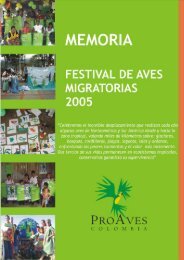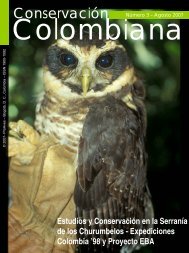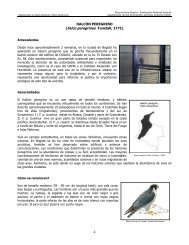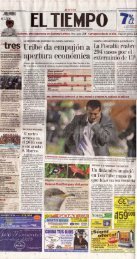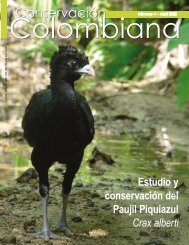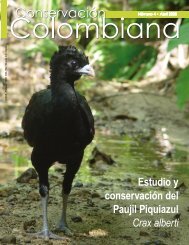Banders' Guide To Identification of Empidonax Flycatchers ... - Proaves
Banders' Guide To Identification of Empidonax Flycatchers ... - Proaves
Banders' Guide To Identification of Empidonax Flycatchers ... - Proaves
Create successful ePaper yourself
Turn your PDF publications into a flip-book with our unique Google optimized e-Paper software.
<strong>Banders'</strong> <strong>Guide</strong> <strong>To</strong> <strong>Identification</strong> <strong>of</strong> <strong>Empidonax</strong><br />
<strong>Flycatchers</strong> In Northeastern North America<br />
Robert G. McKinney<br />
198 Parkview Drive<br />
Rochester, NY 14625<br />
This is primarily a condensation <strong>of</strong> the paper by A. R.<br />
Phillips, M. A. Howe, and W. E. Lanyon, "<strong>Identification</strong> Of<br />
The <strong>Flycatchers</strong> <strong>of</strong> Eastem North America, With Special<br />
Emphasis on the Genus <strong>Empidonax</strong>". Whereas that paper is<br />
very helpful in identifying <strong>Empidonax</strong> flycatchers in the<br />
field, it is quite time consuming to use. This paper provides<br />
the essential information in chart form and may be reliably<br />
used to identify <strong>Empidonax</strong> flycatchers in northeastern North<br />
America provided the user is familiar with the original paper.<br />
It also includes material from the North American Bird<br />
Bonding M0nal, Vol. 1, other sources, and personal experiences<br />
<strong>of</strong> the writer. This paper may be used to identify the<br />
following species:<br />
Least Flycatcher .................. <strong>Empidonax</strong> minimus<br />
Yellow-bellied Flycatcher ..<strong>Empidonax</strong>fiaviventris<br />
Acadian Flycatcher ............. <strong>Empidonax</strong> virescens<br />
Traill's Flycatcher ............... Traill's Flycatcher is a<br />
composite <strong>of</strong> Alder Flycatcher (<strong>Empidonax</strong><br />
Alnorum) and Willow Flycatcher<br />
(<strong>Empidonax</strong> traillii) which are separable<br />
in the field using their song but not<br />
considered to be safely identified in the<br />
hand with 95% or greater confidence.<br />
This guide is only for full grown birds, not for birds having<br />
the bases <strong>of</strong> flight feathers (wing and tail) enclosed in<br />
sheaths. It may be used for molting adult birds where a few<br />
sheathed feathers are symmetrical in both wings or on both<br />
sides <strong>of</strong> the tail.<br />
A molting after hatching year (AHY) <strong>Empidonax</strong> after the<br />
breeding season is almost certainly Yellow-bellied or Acadian.<br />
The others migrate from the northeast before wing<br />
molt.<br />
In this guide the following notations are used:<br />
< = less than or shorter than<br />
= greater than or longer than<br />
>> = much greater than or longer than<br />
< = equal to or less than<br />
> = equal to or greater than<br />
p = primary wing feather<br />
Be sure you are completely familiar with the above-referenced<br />
paper before using this guide so you know how to<br />
properly determine each <strong>of</strong> the characteristics and be familiar<br />
with comments on each <strong>of</strong> the species. Also, be sure that the<br />
bird you are handling is an <strong>Empidonax</strong>.<br />
<strong>To</strong> separate Wood Pewee from Empidonaces:<br />
Wood Pewee<br />
wing chord > 75mm<br />
10th primary > 6th primary<br />
9th pirmary >> 7th primary<br />
Empidonac es<br />
wing chord usually < 75mm<br />
10th primary < 6th primary<br />
9th primary only slightly < 7th primary<br />
<strong>To</strong> separate Eastem Poebe from Empidonaces:<br />
Eastem Phoebe<br />
wing chord>> 75mm, usually > 85mm<br />
bill all black<br />
Note: some fall phoebes are very yellow on the<br />
underside.<br />
Empidonaces<br />
wing chord usually < 75mm<br />
bill not all black<br />
The wing chord measurement is <strong>of</strong> the unflattened wing in<br />
the normal resting position, using a ruler with a vertical stop<br />
placed at the bend <strong>of</strong> the wing. Very good light is required<br />
to accurately determine the color <strong>of</strong> the legs. The writer has<br />
observed that <strong>of</strong>ten Least <strong>Flycatchers</strong> are identifiable in the<br />
hand at a glance by their smaller size, absence <strong>of</strong> yellow on<br />
the throat, and orange color <strong>of</strong> the mouth. However, you<br />
Page 62 North American Bird Bander Vol. 13, No. 3
must always check out all <strong>of</strong> the characteristics in the table to<br />
be sure. The writer has found it convenient to record all <strong>of</strong><br />
the characteristics <strong>of</strong> each bird for future reference.<br />
With careful use <strong>of</strong> this guide, 98% or more <strong>of</strong> the <strong>Empidonax</strong><br />
flycatchers should be safely identified. There may very<br />
<strong>Identification</strong> - Full Grown Birds Only<br />
Bird Wing 6th P Formula Wing<br />
Shape Cut Out B Chord<br />
YSI N<br />
Least I 0P < 5P Y most < 5 Most Most < 65 Notched<br />
Rounded SI few < 4 Some 65459<br />
See Note I<br />
Traill's 10P > 5P No Most Most > 66 Even or<br />
Pointed < 6 Few 62-65 Rounded<br />
Few 6-7<br />
Yellow-bellied 10P > 5P Y&SI 66 Even or<br />
Rounded many Few 60-65 Rounded<br />
No few See note 2<br />
Spring-very yellow wash on chest and throat<br />
Acadian 10P> 5P No Most Most > 66 Even or<br />
Pointed > 6 Few 62-65 Rcnded<br />
Some 5.5-6<br />
HY Acadian in juvenile plumage, late summer, have scaly romp and back<br />
well be some individual birds whose characteristics do not<br />
meet the descriptions in the table. These should be released<br />
unbanded.<br />
The author is undebted to Dr. Wesley E. Lanyon for reviewing<br />
and making suggestions on the manuscript.<br />
Tail Bill Mouth Throat Crown<br />
Width Color Color and<br />
Across<br />
Nostril<br />
5.5 Bright White no Back dull Black<br />
Orangeish trace <strong>of</strong> olive or<br />
yellow brownish, some<br />
greenish<br />
Crown darker<br />
< 5.5 Orangeish Pale Back and Dark<br />
gray crown Gray<br />
washed w/<br />
yellow<br />
greenish<br />
< 5.5 Flesh White or Crown and Gray<br />
color to slight back gray<br />
yellow yellow green to<br />
greenish<br />
Y = Yes, S1 = Slight, N = No<br />
All dimensions are in millimeters.<br />
Hatching year (HY) Empidonaces <strong>of</strong> ALL species may have yellow on underside in summer and fall.<br />
Formula B - Distance from tip <strong>of</strong> longest primary to tip <strong>of</strong> 6th primary with wing in normal closed position.<br />
Note - All flycatchers have ten primaries.<br />
Note 1 Sex determination <strong>of</strong> Least Flycatcher References<br />
Wing chord < 59 mm Female<br />
Wing chord > 65 mm Male<br />
Wing chord 60 - 63 mm<br />
If wing chord < (.13 x Formula A) + 61.8<br />
If wing chord > (.13 x Formula A) + 61.8<br />
Female<br />
Male<br />
Note 2 Sex determination <strong>of</strong> Yellow-bellied Flycatcher<br />
Wing chord < 63 mm Female<br />
Wing chord > 68 mm Male<br />
If wing chord < (.42 x Formula J) + 63.4 Female<br />
If wing chord > (.42 x Formula J) + 63.4 Male<br />
Formula A - Distance from tip <strong>of</strong> 10th primary tip <strong>of</strong> 5th<br />
primary.<br />
Formula J - Distance from tip <strong>of</strong> 10th primary tip <strong>of</strong> 6th<br />
primary.<br />
Both measurements made with wing in normal closed<br />
position.<br />
Leg Remarks<br />
Only empid.<br />
to usually arrive<br />
before May 10<br />
Front wing bar<br />
darker and<br />
duller than rear<br />
Wing bars same<br />
color<br />
Phillips, A. R., M. A. Howe, W. E. Lanyon. 1966. Identifica-<br />
tion <strong>of</strong> the <strong>Flycatchers</strong> <strong>of</strong> Eastern North America, with<br />
special emphasis on the genus <strong>Empidonax</strong>.<br />
Bird-Banding. Vol. 37, No. 3: 153-171.<br />
North American Bird Banding Manual, Vol. II, Depart-<br />
ment <strong>of</strong> the Interior, U. h and Wildlife Service, 1977.<br />
Whitney, B. and K. Kaufman. 1985-1986. Thje Empido-<br />
nax Challenge. Part I, II, III, and IV. Birding Vol. 17,<br />
No. 4:151-158; Vol. 17, No. 6:277-287; Vol. 18, No.<br />
3:153-159; Vol. 18, No. 6:315-327.<br />
July-Sept. 1988 North American Bird Bander Page 63



